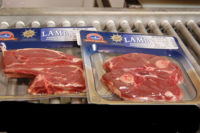Taking aggressive action
By Shonda Dudlicek
Poultry processors are turning to optimized spraying and dipping methods for eliminating pathogens more efficiently
Fears of avian flu aside, poultry processors are adopting more aggressive pathogen control measures and demanding a higher level of performance from the methods they select.
Post-chill dips are gaining popularity as the poultry industry continues to optimize processing with antimicrobials and by achieving the highest food-safety standards for consumers. But sprays and water-chilling also are effective ways to apply an antimicrobial application, either pre-chill or post-chill.
Safe Foods Corp., North Little Rock, AR, offers Cecure, a spray-on, pre-chill antimicrobial application. Poultry is sprayed as it passes on the production line, and the overspray is captured and recycled in the process, leaving no environmental impact. Cecure uses cetylpyridinium chloride, the active ingredient used in mouth rinses and throat lozenges, and is effective in controlling Salmonella, E. coli, and Campylobacter, says Peggy Cook, Safe Foods’ chief scientific officer.
Proper management of free available chlorine levels and related pH levels in immersion chillers can be one of the most important, and possibly overlooked, pathogen-control opportunities, Cook says. Because of this, Safe Foods offers a fully automated chlorine- and pH-management system.
Difficulties in properly treating the chiller also have led to the development of the process in which birds are immersed in a dip tank with a fresh antimicrobial treatment, says Phillip Ellis, senior chemist at Atlanta-based ZEP Manufacturing.
“In the dip, the surface is covered, so it’s much more effective. Whether you’re treating the bird by chilling or by using the post-chill or spray treatment, you should monitor the pH level, the sodium hypochlorite, or bleach, in the chiller,” Ellis says. “There’s a narrow pH range that you need to function at to be effective. It really doesn’t work to optimum effectiveness. You have to monitor and establish systems and control.”
Newer systems are less labor-intensive. The ZEP Antimicrobial Treatment System was originally designed for online reprocessing of visceral split or ruptured birds, which were pulled off the line and processed manually. But now, Ellis says, flooding the cavity to overflowing with a chlorine dioxide solution eliminates a lot of labor.
“Post-chill, this does a good job for online reprocessing and has benefits to kill micro-organisms. The post-chill is similar to antimicrobial; it’s a parasitic acid band product,” Ellis says. “Now what you run into is the possibility of the birds in the vat being contaminated. It basically becomes a soup. If you have one bad bird out of a hundred, then all one hundred birds can be affected, all because of one bad bird.”
Ecolab Inc., St. Paul, MN offers its Sanova antimicrobial program, an immersion dip tank. It is often used after the chiller but can be applied before the chiller, depending on a plant’s layout, says Tom Arata, vice president of marketing for Ecolab’s food and beverage division.
Ecolab’s Sanova process was validated by a study performed in a poultry plant by Auburn University. The study examined the effects of post-chill application of acidified sodium chlorite to control Campylobacter and E. coli on commercial broiler carcasses. Carcass rinses were collected before the inside-outside-bird washer, after the IOBW, post-chill, and after the post-chill application of acidified sodium chlorite. A significant reduction in Campylobacter and E. coli counts and Campylobacter prevalence was seen after the post-chill application of acidified sodium chlorite.
The study showed the antimicrobial effect of acidified sodium chlorite post-chill may be used to significantly reduce Campylobacter and E. coli in commercial broiler carcasses. Chemical decontaminations used post-chill may help reduce the volume of water needed pre-chill and may provide longer contact time for the chemical to achieve a lethal effect on foodborne bacteria. Post-chill systems may eventually be used in different applications such as mist, spray or bath, which could be applied closer to the final stages in processing.
Some customers use a poultry spray to reduce microbial contamination on processed poultry surfaces, says John Richards, vice president of marketing and development for meat and poultry at Ecolab. But the move is on toward dip and full immersion.
“Acidified sodium chlorite takes the chlorite and puts it in an acid state,” he says. “A dip has full contact with the bird and can accurately get exposure and all properties you can control in a poultry plant.”
A dip requires more than 10 seconds and less than 30 seconds at tap-water temperature. MBA Suppliers sells used chillers, and Bill Krupa, executive vice president of the Omaha, NE-based company, says he’s seen a dramatic increase in plants chilling birds quickly. To accommodate that, Krupa says, machines have become larger, with some requiring 600 tons of ammonia to power the plate chiller.
Marlen Research Corp., Overland Park, KS, offers liquid-chill and air-chill, both after the product is cooked for latent heat removal. Liquid-chill uses a mix of water and sodium chlorite, a brine solution. The chill temperature is 12 degrees for the brine temperature. Air-chill refrigerates with an air blast in a chill room at no less than 20 degrees, from 20 minutes to 8 hours depending on the product. Bill Faivre, vice president of national accounts, says air-chilling is considered safer, but the process is not perfect. Marlen’s equipment chills at higher temperatures for greater efficiency.
“The higher temperature delivers that buzzword: a higher yield,” he adds. NP
Shonda Dudlicek is a freelance writer in the Chicago area.
U.S. bird flu outbreak unlikely
The world is watching to see if the infectious avian influenza H5N1 virus develops the capacity to spread easily from person to person, which could lead to a global epidemic.
At presstime, the lethal strain of bird flu was reported in 15 countries; 150 million birds had died or been culled, and poultry losses worldwide had topped $10 billion.
But could a bird flu outbreak happen here in the United States? Not likely, experts say.
No chickens or turkeys known or suspected to be infected with bird flu are processed for sale as raw meat in the United States, according to the National Chicken Council. Handwashing after handling raw poultry is always a good precaution, but U.S. consumers have virtually no chance of encountering meat from a chicken or turkey infected with bird flu.
The United States has no cases of the H5N1 HPAI strain and doesn’t import poultry from the affected Asian countries.
As a large poultry exporter, virtually all chicken and turkey sold here is produced here. A stateside outbreak could be devastating to the U.S. poultry industry, as it could bring significant losses and a ban on exports.
If HPAI were detected in this country, the chance of infected poultry entering the food chain would be extremely low. There is no danger of acquiring bird flu from normally and properly cooked food. The bird flu is caused by a virus, and it’s destroyed – like all types of viruses – by the heat of normal cooking, according to the NCC.
“This is a health issue, not a food-safety issue,” says Michael Rybolt, manager of scientific and regulatory affairs at the National Turkey Federation.
If an outbreak were to occur, flocks infected with the H5 or H7 types of virus would be destroyed in order to prevent the virus from evolving and spreading. Poultry companies and producers practice strict biosecurity, which is heightened during any outbreak.
Those most vulnerable are people working in U.S. growout houses, who might be around flapping wings and the spreading of fecal matter, says Phillip Ellis, senior chemist at Atlanta-based ZEP Manufacturing.
“There have been more risks when you’re moving trucks from one farm to another,” Ellis adds. “We’re starting to see some requests for sanitizing and disinfecting. You can’t truly treat everything at the houses, but you can sanitize and disinfect.”
Ellis says it’s important to monitor the cleanliness of the vehicles and treat them with a foam or bath treatment for tires. An outdoor situation is tougher to control, but transportation must be made a priority, he says.
Frequent handwashing, hand sanitizers, and antimicrobial rinses can help reduce transmission of the flu virus. Many products are effective in killing other flu strains, but as Susan Nestegard, senior vice president and chief technical officer at St. Paul, MN-based Ecolab says, “Nothing is certain to be effective against a strain that can transmit easily among humans until the strain exists and can be analyzed and tested in a lab.”
Unless HPAI makes that jump, however, consumers can take the necessary sanitary precautions when handling poultry, but generally breathe easier about the safety of the poultry products they are handling.
Process Improvements
Crust-freezing improves shelf life
Surface freezing, thought to be harmful to products, is now a viable process for rapidly cooling meat cuts, provided the freezing is fast and even, according to a Swedish study.
Crust-freezing, which chills meat cuts using the impingement technique, is an efficient cooling method that can give better production yields, improved product quality and longer shelf life, according to researchers at FMC Technologies.
Impingement uses high air velocity and low temperature to freeze quickly. Meat is brought through the freezer on a six-foot-wide, linear belt that can vary from 20 to 100 feet long. Refrigerated air circulates at 100 to 150 feet per second.
“When you freeze it quickly, the ice crystals are smaller,” says Torbjorn Persson, freezer product line manager at the Swedish offices of Chicago-based FMC FoodTech. “If it’s frozen slowly, the walls of each cell get cracked, and when it thaws, the juice will leave the item. Then you’ve got drip loss. The liquid leaves the product because of the way it’s frozen and thawed.”
Impingement using an Advantec freezer is popular in Europe, Persson says, and FMC Technologies expects to introduce it in the United States next year. From a food-safety standpoint, shelf life is extended through crust-freezing.
Crust-freezing can achieve two end results, rapid chilling and surface stabilization. Rapid chilling is used for meat that is sold chilled, and the frozen crust enables it to be stored.
“You’re freezing a very thin crust on the product so you can treat it as a fresh product,” Persson says. “This fights aging and drip loss.”
In surface stabilization, the meat has a frozen crust but it’s cut it into portions.
“You’re stabilizing the meat,” Persson explains. “Especially on a round meat, you can run it through to stabilize it. And you get a good, quality cut for portions and slicing, to get more precise cuts.”


Report Abusive Comment